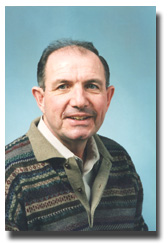
Eustace Families Association

Ronald F. Eustice
1945-
Ronald
F. Eustice became the owner of his
first bovine at the age of 15 months when his parents purchased a Brown Swiss
heifer by cashing in a savings bond that his great-grandfather had given him.
Since then, Ron’s interest in the cattle business and his commitment to
agriculture have never wavered. Whether on the family farm in Steele County, in
the jungles of Java, the mountains of Mexico or the pampas of Paysandu, he has
never missed an opportunity to be an ambassador for US agriculture and to serve
as a credible spokesman for the beef and dairy industries.
Like
many of us, Ron was not born into wealth or fame. He learned at an early age
that the road to success is paved by hard work, perseverance, strong personal
relationships and an occasional stroke of good luck. He also learned that there
are a few cobblestones and an occasional detour along life’s journey. He has
been blessed by the strong support from his loving wife of 25 years, Margaret
McAndrews.
Ron
and Margaret have 3 children, Kevin (24), John (21) and AnnMarie (17). Kevin is
in graduate school at UCLA (Computer Engineering), John is a junior at the
University of Minnesota (Horticulture) and AnnMarie is a high school junior at
the Academy of the Holy Angels in Richfield.
Born
at Waseca, Minnesota, Ron was the oldest of four children of Donald & Alice
Mae (Perron) Eustice. He grew up in Deerfield Township, Steele County, attended
a one-room country school through 8th grade and graduated from
Owatonna High School. Early involvement in 4-H activities helped create a
continuing interest in livestock. He participated in dairy, swine, lamb and
junior leadership projects during his 4-H career. Newly arrived Steele County
Extension Educator Larry Tande helped keep Ron on the right track in those
formative years. In high school, he participated in FFA and was a member of the
Minnesota State Fair Champion Dairy Judging team. That taste of victory was an
incentive to continue participation in judging activities. Later, under the
guidance of Dr. Garth Miller, Ron was a member of a national champion
intercollegiate dairy cattle judging team and placed 8th at the
national contest in Waterloo, IA. Fellow judging team members, Floyd Marti and
Dave Pierson made sure that Ron placed the classes right and that his reasons
were on target. That same year, when Dr. Chuck Christians was short of judges
for his first University of Minnesota’s General Livestock Judging Team, Ron
answered the call. That hastily put together team placed a respectable 8th
at the National Western Livestock Show.
It
was during Ron’s years at the University of Minnesota that he took an interest
in Red & White Holsteins. He began to purchase a few well-bred Red &
White calves from respected Minnesota herds including Apple Acres and Orbit
Farms and from other prominent herds in the US and Canada. Several of these
animals including Color Crest Miss Scarlet (bred by Wayne & Harriet Brown)
had a major impact on the Red & White Holstein breed. Color Crest Miss
Scarlet was Reserve Champion at the first National Red & White Show held at
the World Dairy Expo and topped the national sale. Ron served on the board of
directors of the Red & White Dairy Cattle Association for several years and
managed the First National Red & White Sale in 1970. In the 1970’s Ron and
Margaret developed a high quality herd of purebred Simmental cattle in
California.
In
1981, Ron and Margaret brought their family back to Minnesota when he became
Executive Secretary of the Minnesota Holstein Association. While at Minnesota
Holstein Association, he initiated a highly successful private treaty sales
service called “Marketplace” and selected cattle for some of Minnesota’s
most successful state sales. Minnesota Holstein Association membership increased
significantly.
Ron
Eustice’s contributions to the livestock industry are many, but there is one
that stands out above the rest. The Centers for Disease Control estimates that
food borne illness strikes 76 million people annually. Approximately 5,000 die
from harmful bacteria consumed at the dinner table. Pasteurization, fluoridation
and immunization became the pillars of human health in the 20th
century. Yet another technology, food irradiation, has been around for most of
the past century, but consumers and food manufacturers were reluctant to use the
process because of fear and misunderstanding.
In
1997, under Ron’s leadership, the Minnesota Beef Council began a highly
coordinated education effort to make beef one of the safest foods on the dinner
table. Meat irradiation was a key element. The Beef Council studied the
irradiation process. Cooperation with companies such as Huiskens Meats and
Cargill who shared an interest in irradiation began. Together with the Minnesota
Department of Health, the Beef Council conducted workshops, served thousands of
irradiated beef samples, sent letters to the editor and wrote press releases.
Consumer interest and understanding grew in direct proportion to the amount of
information available to them. Today, Minnesota is the undisputed leader in the
production and marketing of irradiated ground beef. Distribution of irradiated
ground beef has gone nationwide in just six months. Chandler, MN -based Huiskens
Meats is marketing frozen patties in more than 2000 stores, while Schwan’s
directly markets in 48 states. Consumer acceptance of irradiated patties has
been way beyond expectations. Hundreds of lives will be saved as a result of
meat irradiation. Minnesota Beef Council led the charge with Ron Eustice and MBC
Chairman Dennis Swan waving the flag. BEEF magazine recently recognized MBC
chairman Dennis Swan of Balaton as “Trailblazer of the Year” in recognition
of Minnesota efforts to promote irradiation as a food safety tool. This national
award recognizes one beef producer each year who in the opinion of BEEF magazine
did the most to move the industry toward its goals.